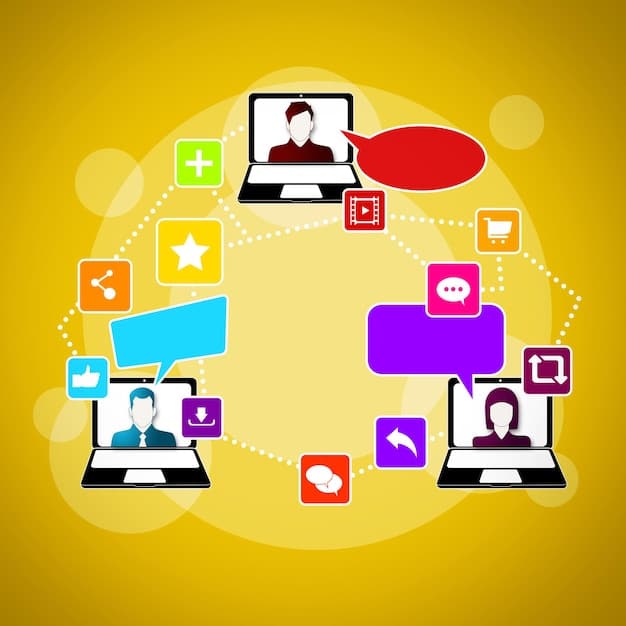Effective Communication Strategies for Remote Teams: A Comprehensive Guide

Effective communication strategies are crucial for seamlessly collaborating with remote teams, fostering productivity, and maintaining team cohesion across different locations and time zones.
In today’s interconnected world, remote teams are becoming increasingly common. Mastering effective communication strategies is no longer a luxury but a necessity for seamless collaboration and overall success.
Why Effective Communication Matters for Remote Teams
Effective communication is the backbone of any successful team, but it takes on an even greater significance when team members are geographically dispersed. The absence of face-to-face interaction in remote settings can create unique challenges that can impact team morale, productivity, and project outcomes.
Building Trust and Rapport
Without regular face-to-face interactions, it can be difficult to build trust and rapport among team members. Clear, consistent, and open communication can help bridge this gap, fostering a sense of camaraderie and mutual respect.
Preventing Misunderstandings and Conflicts
Remote work can increase the likelihood of misunderstandings and conflicts due to the lack of non-verbal cues and contextual information. By establishing clear communication protocols and encouraging active listening, teams can minimize these issues.
- Establish clear communication channels for different purposes.
- Encourage active listening and provide regular feedback.
- Document important decisions and action items.
Ultimately, effective communication is not just about exchanging information; it’s about creating a shared understanding and sense of purpose within the team, which is essential for achieving common goals.

Choosing the Right Communication Tools
Selecting the right communication tools is a critical step in fostering effective collaboration within remote teams. The array of available options can be overwhelming, but understanding the specific needs of your team and projects can help you make informed decisions.
Asynchronous vs. Synchronous Communication
Consider the balance between asynchronous and synchronous communication tools. Asynchronous tools, such as email or project management software, allow team members to communicate at their own pace. Synchronous tools, such as video conferencing or instant messaging, facilitate real-time interaction.
Video Conferencing Platforms
Video conferencing tools are essential for replicating face-to-face interactions and building team cohesion. Platforms like Zoom, Microsoft Teams, and Google Meet offer features like screen sharing, virtual backgrounds, and breakout rooms, facilitating seamless collaboration.
- Use video conferencing for team meetings and important discussions.
- Choose project management software that integrates with other communication tools.
- Prioritize communication tools that are user-friendly and accessible.
By strategically selecting a range of communication tools, remote teams can optimize their workflows, enhance collaboration, and maintain a strong sense of connection.
Establishing Clear Communication Protocols
Establishing clear communication protocols is essential for ensuring that information flows smoothly and effectively within remote teams. Without these protocols, misunderstandings, delays, and inefficiencies can quickly emerge.
Defining Communication Channels
Clearly define which communication channel should be used for different types of information. For instance, urgent messages might be sent via instant messaging, while more detailed discussions could take place via email or video conferences.
Setting Expectations for Response Times
Establish clear expectations for response times to ensure that team members are promptly addressed and projects stay on track. Clearly communicate availability and time zones, setting boundaries to prevent burnout.

- Provide guidelines for writing clear and concise emails and messages.
- Implement a system for documenting important decisions and action items.
- Prioritize creating a culture of open communication and feedback.
By collaboratively establishing clear communication protocols, remote teams can create a productive and harmonious work environment that allows everyone to thrive.
Fostering a Culture of Open Communication
Fostering a culture of open communication is paramount for the success of remote teams. When team members feel comfortable sharing their thoughts, ideas, and concerns, it creates an environment of trust, innovation, and collaboration.
Encouraging Feedback and Suggestions
Actively encourage team members to provide feedback and suggestions on processes, projects, and overall team dynamics. Implement regular feedback sessions and create anonymous feedback channels, making every voice heard.
Promoting Active Listening
Promote active listening skills among team members to ensure that everyone feels heard and understood. Encourage mindful engagement in discussions, asking clarifying questions, and summarizing key points to demonstrate comprehension and respect.
In the context of remote work, a culture of open communication can mitigate the challenges of physical distance, support team cohesion, and drive overall success.
Overcoming Communication Barriers in Remote Teams
Remote teams often face unique communication barriers that can hinder collaboration and productivity. Understanding these challenges and implementing strategies to overcome them is crucial for fostering a cohesive and effective work environment.
Time Zone Differences
Time zone differences can present significant challenges for scheduling meetings, coordinating projects, and maintaining consistent communication. Implement flexible scheduling options, rotating meeting times, and utilizing asynchronous communication tools to accommodate the different time zones.
Cultural Differences
Cultural differences can also create communication barriers within remote teams, particularly when team members come from diverse backgrounds and locations. Offer cultural sensitivity training, promote awareness of cultural norms and communication styles, and foster an inclusive environment that values diversity.
- Encourage empathy and understanding among team members.
- Provide language support and translation services, when necessary.
- Continuously evaluate and refine communication strategies.
By proactively addressing and resolving these communication barriers, remote teams can strengthen their relationships, enhance collaboration, and achieve their goals more effectively.
Measuring and Improving Communication Effectiveness
Measuring and improving communication effectiveness is an ongoing process that ensures remote teams continue to thrive. By regularly assessing communication strategies and making necessary adjustments, teams can enhance collaboration, productivity, and overall success.
Utilizing Surveys and Feedback Forms
Implement regular surveys and feedback forms to gather insights from team members about their communication experiences. Ask specific questions about communication clarity, frequency, and effectiveness, and analyze the responses to identify areas for improvement.
Analyzing Communication Metrics
Analyze communication metrics such as response times, message volumes, and participation rates to gain a deeper understanding of how communication is flowing within the team. Use data analytics tools to track trends, identify bottlenecks, and measure the impact of communication initiatives.
- Set clear goals for improving communication effectiveness.
- Foster a culture of continuous improvement and experimentation.
- Regularly evaluate and update communication strategies.
Measuring and improving communication effectiveness is an investment in the long-term success of remote teams.
| Key Point | Brief Description |
|---|---|
| 🗣️ Clear Protocols | Establish guidelines for communication channels and response times. |
| 🛠️ Right Tools | Choose tools that facilitate both synchronous and asynchronous communication. |
| 🌍 Overcome Barriers | Address time zone and cultural differences proactively. |
| 👂 Active Listening | Promote understanding and respect through active listening. |
Frequently Asked Questions
▼
Key elements include clear protocols, the right communication tools, fostering open communication, addressing time zone differences, and promoting understanding through active listening within the team.
▼
Remote teams can manage time zone differences by implementing flexible scheduling, rotating meeting times, and utilizing communication tools like e-mail or project management software.
▼
Communication tools are vital for keeping team members connected irrespective of time or place. They aid in seamless discussions, real-time problem-solving, and help enhance team collaboration, which boosts productivity.
▼
Feedback aids in improving processes, resolving concerns, and boosting morale, so implementing feedback channels and surveys is crucial to ensure every voice is heard, which impacts team cohesiveness and overall success.
▼
Cultural differences can lead to misunderstandings due to varied communication styles and norms, so promoting cultural sensitivity via awareness training and inclusive environments can bridge these gaps.
Conclusion
In conclusion, effective communication strategies are essential for the success of remote teams. By prioritizing clarity, establishing protocols for communication, choosing the appropriate tools, fostering open dialogue, and proactively addressing potential barriers, remote teams can optimize their productivity, cohesion, and overall performance in today’s global and distributed work environment.





